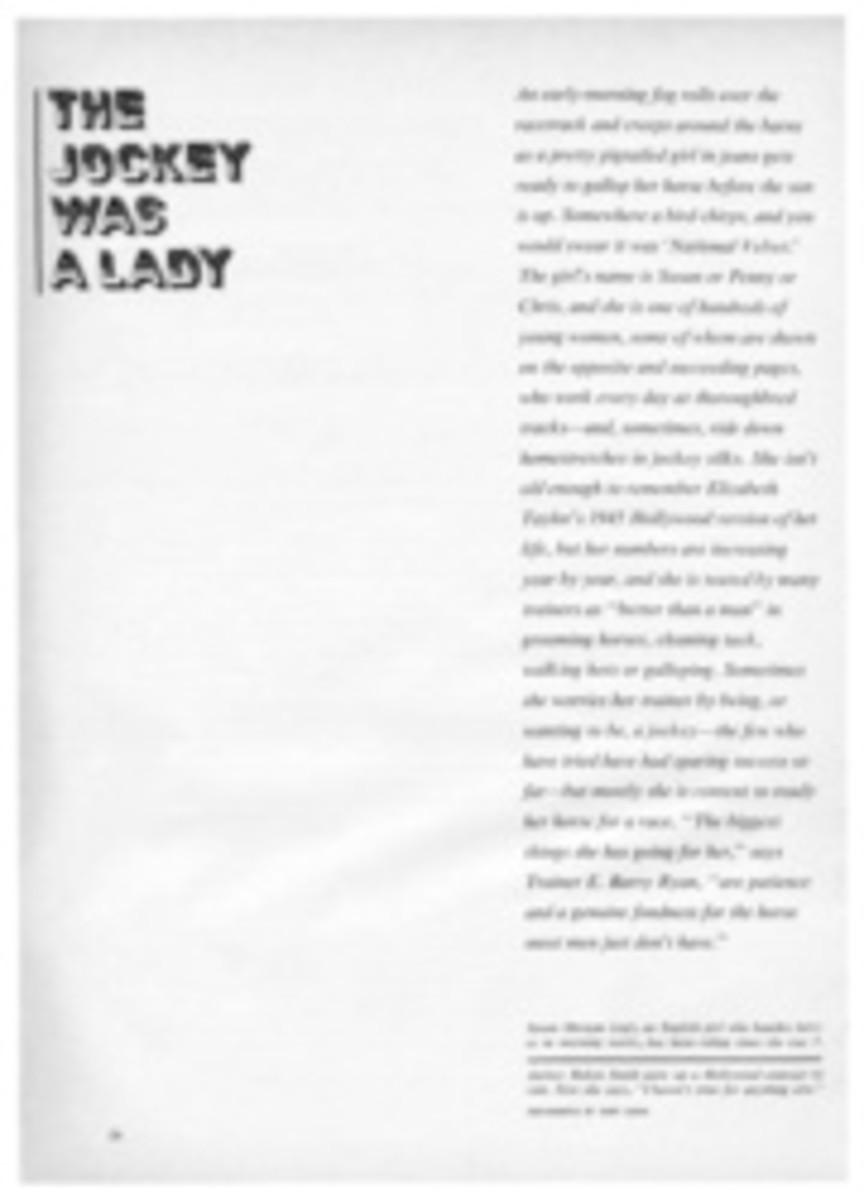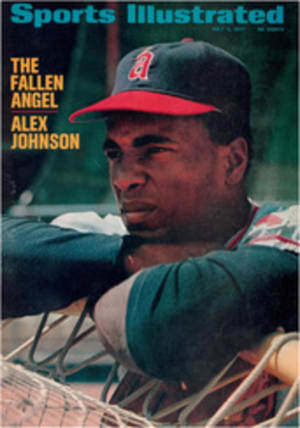
The Major Made It on a Bike
His specialty was the "jump"—a lunging sprint within a sprint. Warily watching for a gap in the ranks of his persecutors, the little black bike rider would put his nose even closer to the front tire than it had been, raise his haunches higher into the wind and wiggle through to break the finish tape. At the turn of the century such tactics won the man known as "Major" Taylor a lot of money, the adulation of thousands and the hearty dislike of most of his fellow competitors.
In the rugged world of professional bicycling circa 1900, Marshall Taylor was a rarity not only because he was black but because he was a teetotaler who deplored the use of tobacco and would not race on the Sabbath. He was, besides, a sensitive battler for equal rights and wrote touching verse in which he compared his "white" inner being with the "black" souls of the men his ambitions forced him to compete against. All this at a time when his country was tightening rather than relaxing the rules of Jim Crow.
Acknowledged as the "fastest bike rider in the world" 10 years before Jack Johnson won the world heavyweight boxing championship, Taylor was, however, a darling of the sportswriters in the '90s and his appearances at the steeply banked cycling ovals brought warm cheers from thousands of spectators. Yet, because of his color, he was held in contempt by most of his racing rivals and, of course, regularly barred from restaurants and hotels.
Marshall Taylor was born in 1878 in Indianapolis, one of eight children of the coachman for a wealthy businessman. A son of the family in the big house occasionally let the black child borrow his bike, and in no time Marshall showed the white boy tricks he never dreamed of. Soon Marshall proved he could excel in all sports except swimming, which he could not learn properly because he was routinely barred from the YMCA swimming pools.
Taylor's first job was sweeping up the store and demonstrating trick riding for a bike dealer in his home town. Without Marshall's knowledge, the dealer entered his name in a 10-mile race, which he easily won, thus getting his first gold medal on a "standard" with solid rubber tires when he was just 13 years old. The new type bicycles, like those we see today, with pneumatic tires, drop handlebars and other modern gadgets, were just coming into fashion, and bicycling itself had become the newest craze. Eager amateur and professional cycling leagues, indignation over "scorchers" on the public highways, and Major Taylor all arrived on the American scene at about the same time.
Sport bicycling attracted a host of paying spectators and became a fast-buck business with the inevitable superstructure of roguish agents, raffish track managers and other hustlers. Tough, young athletes trained hard to master the new advances in cycling technology. Taylor himself experimented with all sorts of new styles of handlebars to lower wind resistance and once had a bike that weighed only 15 pounds. He and his fellow racers competed for purses that ranged to $1,000 and more as the promoters tried to outbid each other for the stars.
In keeping with the segregation that was standard in American society, there was one racing circuit exclusively for blacks that had its own schedules, heroes and betting apparatus. Called the Negro Cyclists' League, it was especially strong in the South, but Major Taylor would have nothing to do with such minor league cycling (with its correspondingly smaller purses). He much preferred to battle the color bar on the white folks' tracks. Once he was cheeky enough to register for a race in Savannah, Ga., but before he could be strapped into his pedals some so-called White Riders ran him out of town.
Even up North Taylor lived with threats against his life. Once in Boston, W. E. Becker, a cyclist Taylor had just nosed out, choked the black man into insensibility as thousands watched. Usually, however, the Major could depend upon crowd sentiment to favor the principle of nondiscrimination. Often, when a combine of cyclists who "drew the color line" (to employ a phrase of the time) used technicalities to bar Taylor from a chance at the large purse, his partisans would enter his name secretly. Taylor had many partisans, particularly in the press. Editorial writers condemned the rawest conspiracies against him and, using various point systems to back their case, sports reporters determined that Taylor was the American champion of professional cycling from 1898 to 1901. But he was never officially proclaimed as such.
Taylor attracted sympathy because, superficially at least, he gave the impression of being a modest underdog. In fact, his handicaps were but skin-deep. He was a clever tactician who broke to take the lead very late in races because he liked to use his competitors as windshields for as long as possible. After tailgating along in their wake, he would use his last reserves of power to jump through for final victories. His adversaries bumped him openly, but he would elbow them deftly in passing. Faced with their taunts and menacing gestures, the Major would retort by smiling with forbearance and quoting some psalm or other.
A physiologist once examined Taylor's body with care and declared his physique perfect for the sport he chose. He had small shoulders, a thick chest holding a strong heart and heavy thighs, with the rest of his body pared narrow. His ankles and wrists were elegantly slim, and the fact that his dark brown skin was shiny smooth seemed evidence of some kind of genetic conspiracy to pass him through the air even more slickly.
Off the track, Major Taylor heightened the general impression of physical perfection by dressing like a cultivated businessman, but in competition he wore skintight outfits in black and baby blue. His jersey had rows of pearl buttons along the edges of his shoulders. The crude dress of his rivals heightened Taylor's elegance.
In time, bike racing evolved all sorts of specialists. There were the distance men who would attack space with time, or vice versa. That is, they would attempt a standard distance such as 10,000 meters or 1,000 miles, or they might see how far a man could travel in an hour, a day or a week. Then there were the six-day cyclists, not true distance men but athletes who could do hundreds of successive sprints in the period of time between two Sundays.
As a beginner Taylor had entered six-day races, but his specialties lay more in all-out efforts for stretches of a mile or less. When he was 15 years old, he managed to do a five-lap mile in 2:11 from a standing start. Later, as a professional, he became a celebrated figure in a long tournament that had as its object the cycling of a mile in the least possible time. The best cyclists began to pursue records for the flying mile, and then for the mile done behind pacers. Those five-man tandems that one sees in tintypes with big, grim-faced men posed before them were not jokes. The long machines were especially built for the purpose of cutting wind resistance in front of following soloists who were trying to raise their velocity to the magic figure—a holy grail of the epoch—"a mile a minute."
The Ebony Streak of Black Cyclone, as some sportswriters dubbed Taylor, was the hero of many well-publicized attacks on the mile. Eventually he settled on steam pacers, for they could be revved up faster than the tandems. Some of the first vehicles made by the Stanley Steamer Company were expressly ordered as Taylor's windbreaks. With first the long tandems and then the hissing steam pacers running interference, Taylor brought the record for the paced, flying mile to 1:41, then to 1:31[4/5] and finally to 1:19.
Unfortunately for Taylor, the one-minute-mile barrier was breached on June 30, 1899 by a New York policeman named Charley Murphy who stole a march on the whole cycling world. With his gear ratios set for 31 feet per revolution, Murphy spun the crank at 175 rpm, and he did it in the near vacuum created by a shield pulled by a big locomotive over a special track of the Long Island Rail Road. But Taylor bore Murphy no grudge. Afterward, Murphy and Taylor, two of the most glamorous figures on the silent steeds—as cycles were called—toured as a team in vaudeville, grimacing and sweating on treadmills for cheering ticket holders.
Taylor probably met his warmest admirers abroad. He left for his first trip to Europe in 1901. The French smiled when they heard that the Yank would not race on Sundays, and they were incredulous when Taylor clucked with disapproval upon observing some European champions drinking wine with their lunches. But the sports reporters in Paris admired the American, both as a performer and as a dandy. The "sprinter noir," they wrote, was "beau" "tr√®s harmonieusement b√¢ti" and "un diable de négrillon." Ever a patriot, Taylor demanded that his appearances be greeted by a band playing The Star-Spangled Banner. In Paris on May 27, 1901, after he had beaten the European champion, Edmond Jacquelin, Taylor caused a sensation during his cooling-off laps by waving a little silk American flag he had secreted in his belt.
Soon promoters beckoned from Australia. The Aussies were enthusiastic cycling fans, but they also had firm rules barring Orientals and blacks. So great was Taylor's reputation as a performer, however, that these proscriptions were put aside. When Taylor arrived for his first Australian tour in Sydney in 1903, thousands greeted his ship and all the bands that could be amassed played The Star-Spangled Banner.
In the course of Taylor's second Australian tour in 1904, the promoters imported a few other American riders, and some of them again harassed their black rival. Soon after this Taylor began to lose frequently. At last, gathering his winnings, which were substantial, he retired to Worcester, Mass., which had one of the few YMCAs that would not bar him from its swimming pool.
Taylor tried a comeback in 1908, but by then professional cycling had many rivals for spectator interest, including automobile races. The motor pacers' descendants were now roaring on their own tracks without cyclists tailing them. And Taylor himself had lost much of his young power.
Still fit and handsome, Taylor occasionally sped madly over the splintered, graying surfaces of the cycling tracks. And he always tried his hardest in the sentimental oldtimers' races. But as time passed, his appearances became fewer and fewer, and soon Marshall Taylor's efforts to break the color barrier in sports were forgotten. It remained for other Negro athletes to do the same work all over again long after the Black Cyclone had hung up his shoes. But it is well to note for the record that the little Major was one of America's first black national champions.

